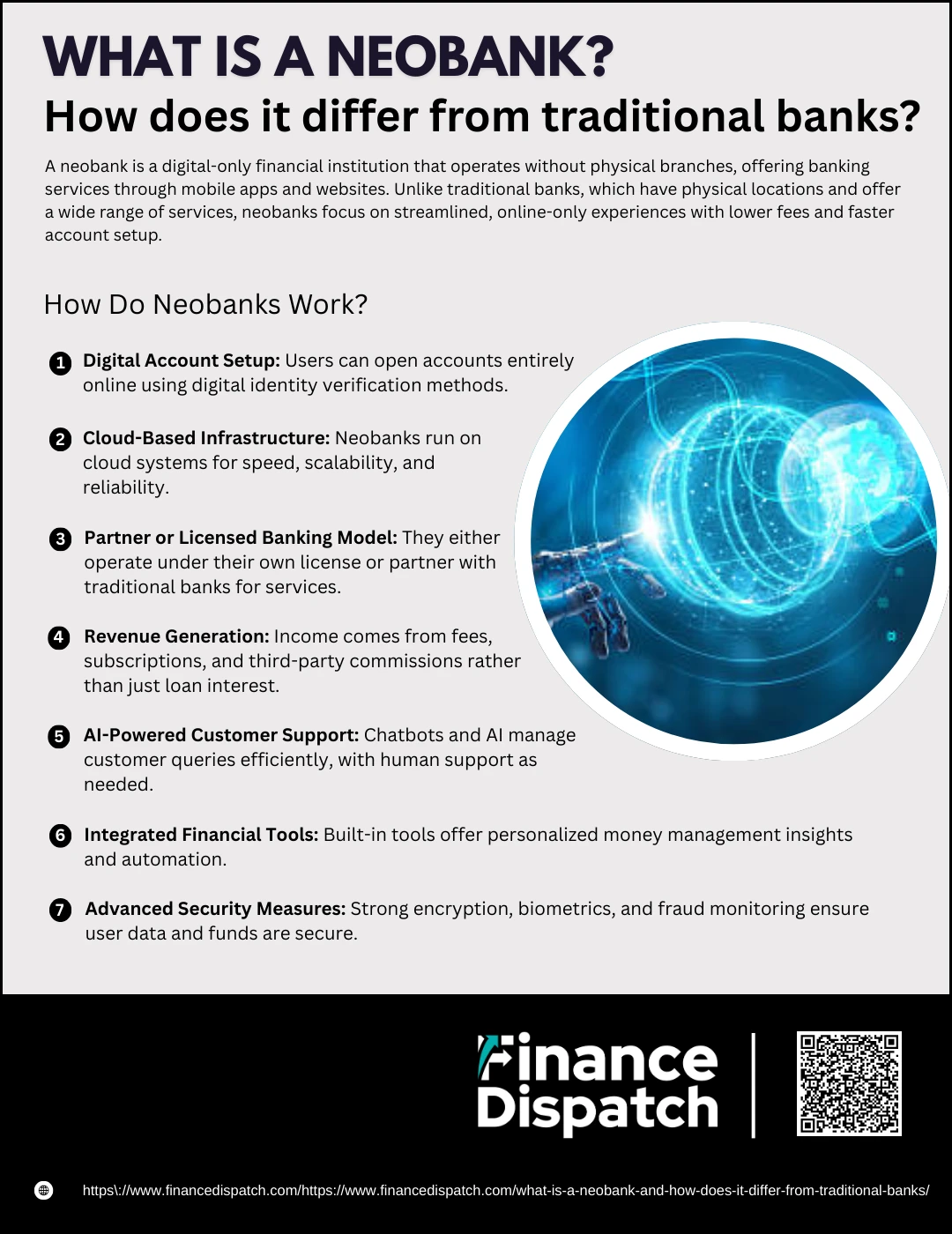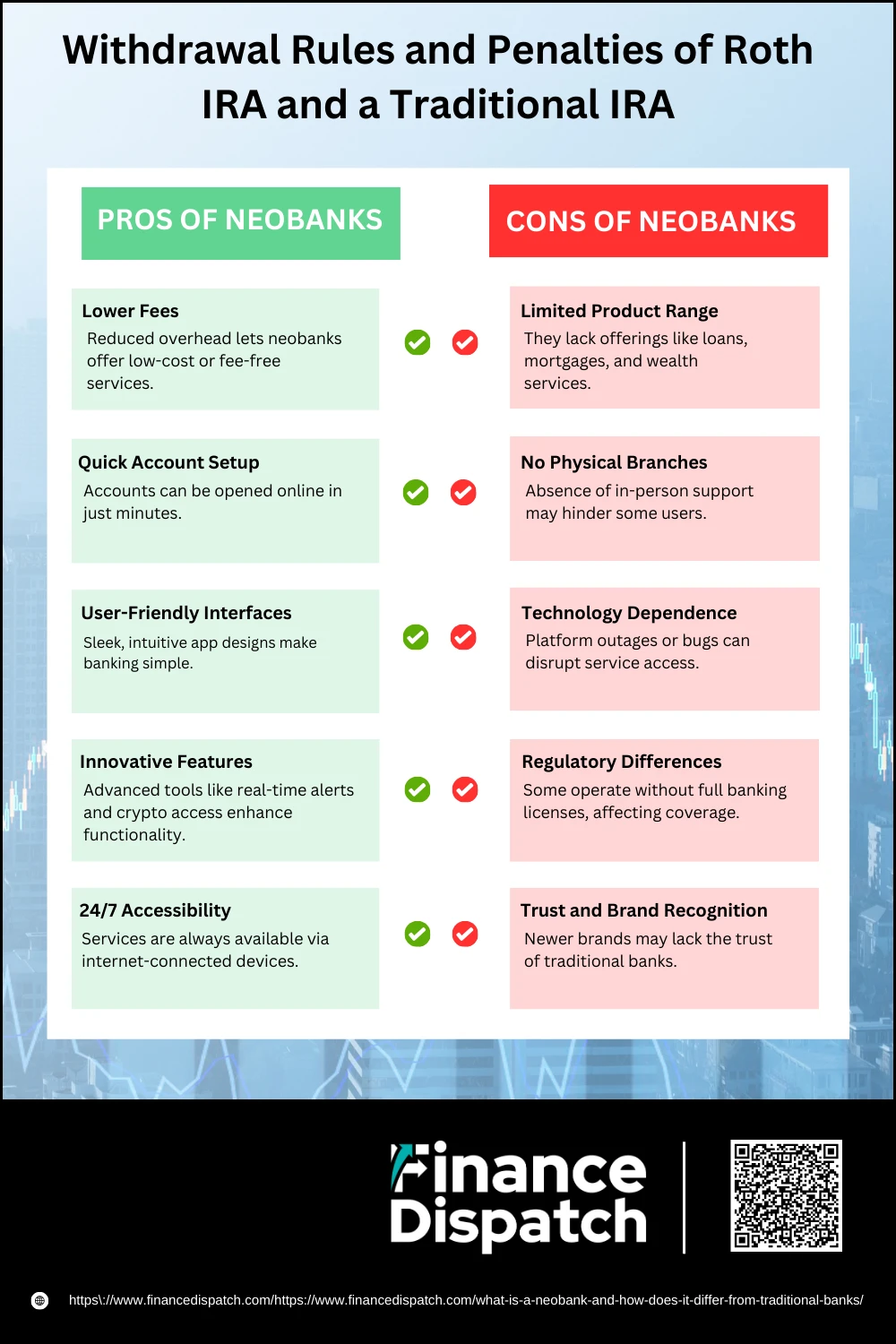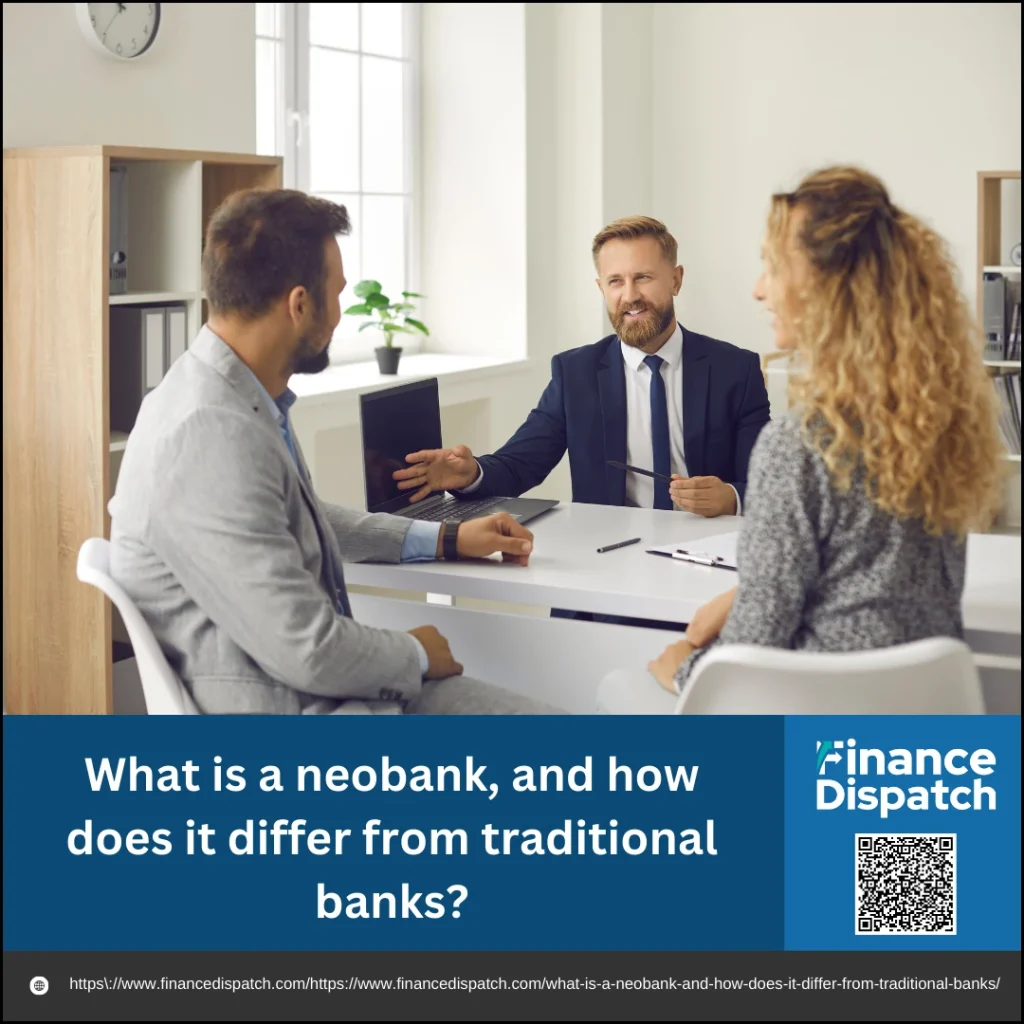In an increasingly digital world, the way we manage money is evolving rapidly—ushering in a new wave of banking known as neobanking. Neobanks are digital-only financial institutions that operate without physical branches, offering streamlined services through mobile apps and web platforms. While traditional banks have long been the cornerstone of financial systems, neobanks are reshaping expectations with their technology-driven, customer-centric approach. This article explores what neobanks are and how they fundamentally differ from traditional banks in structure, service, and strategy.
What is a Neobank?
A neobank is a type of financial institution that operates entirely online, without any physical branches. Unlike traditional banks, neobanks offer their services exclusively through mobile apps or web platforms, making banking more accessible and convenient for tech-savvy users. They focus on core banking functions such as checking and savings accounts, payments, and budgeting tools, often with lower fees and faster service. Some neobanks operate with a full banking license, allowing them to offer insured deposits and loans independently, while others partner with licensed banks to provide regulated services. Their digital-first model allows for streamlined operations, personalized experiences, and rapid innovation.
The Rise of Neobanks
The rise of neobanks can be attributed to a combination of technological innovation, shifting consumer expectations, and evolving regulatory frameworks. Advances in mobile technology, cloud computing, and cybersecurity have enabled neobanks to offer secure, user-friendly banking services without the need for physical branches. At the same time, modern consumers—particularly millennials and Gen Z—demand speed, convenience, and personalization, all of which neobanks are well-positioned to deliver. Regulatory changes, such as Europe’s revised Payment Services Directive (PSD2), have also opened the door for increased competition by allowing third-party access to bank data. Together, these factors have fueled the rapid expansion of neobanks, reshaping the global financial landscape.
 How Do Neobanks Work?
How Do Neobanks Work?
Neobanks represent a new generation of banking, one that is completely digital and tailored to modern lifestyles. Unlike traditional banks that depend on branches, paperwork, and manual processes, neobanks use technology to simplify and personalize banking. Their mobile-first approach appeals especially to tech-savvy individuals who expect on-demand access to financial services. By eliminating the overhead costs of physical infrastructure and automating most operations, neobanks are able to provide faster, cheaper, and more efficient banking solutions. Here’s a closer look at how neobanks operate behind the scenes:
1. Digital Account Setup
Opening an account with a neobank is quick and fully online. Users download the app, submit personal information, and verify their identity through digital KYC (Know Your Customer) methods, such as uploading ID documents or using facial recognition.
2. Cloud-Based Infrastructure
Neobanks rely on cloud computing to host their services, allowing them to operate with high flexibility, speed, and scalability. This infrastructure helps manage large volumes of data, ensures reliable performance, and reduces downtime.
3. Partner or Licensed Banking Model
Some neobanks are fully licensed and can operate independently, while others use a partnership model—collaborating with traditional banks to offer services like FDIC-insured accounts and payment processing.
4. Revenue Generation
Instead of profiting mainly from loan interest, neobanks generate income through alternative streams such as card interchange fees, subscription tiers for advanced tools, or commissions from third-party products offered via the platform.
5. AI-Powered Customer Support
Neobanks typically use chatbots and AI-driven systems to handle routine customer inquiries efficiently. For more complex issues, human agents are available through in-app chat or email, often with quicker response times than traditional banks.
6. Integrated Financial Tools
Many neobanks include smart tools like automated savings, real-time transaction notifications, spending categorization, and budget planners. These tools use data analytics to provide personalized financial insights and promote better money habits.
7. Advanced Security Measures
Security is a top priority for neobanks. They implement cutting-edge safeguards such as end-to-end encryption, secure APIs, two-factor authentication, biometric logins, and real-time fraud monitoring to protect customer information and funds.
Key Differences: Neobanks vs Traditional Banks
While both neobanks and traditional banks offer financial services like savings accounts, payments, and loans, their approaches and underlying infrastructures differ significantly. Neobanks are digital-native institutions that operate entirely online, focusing on technology-driven convenience and affordability. In contrast, traditional banks rely on physical branches, established processes, and a broad service portfolio to serve a wide range of customers. The table below highlights the key differences between the two:
| Feature | Neobanks | Traditional Banks |
| Banking Model | Digital-only, app/web-based | Physical branches with online and in-person services |
| Licensing | May operate with or without a banking license (via partners) | Fully licensed and regulated financial institutions |
| Customer Access | Accessible 24/7 via smartphone or browser | Requires visits to branches for certain services |
| Service Range | Focus on basic banking services (checking, savings, payments) | Comprehensive services including loans, mortgages, and investments |
| Fees | Typically low or no fees | Often includes various service and maintenance fees |
| Technology | Built on modern, scalable platforms | Often limited by legacy systems |
| Customer Support | Primarily digital (chatbots, in-app chat) | In-person, phone, and online support |
| Target Audience | Younger, tech-savvy, underbanked segments | Broad demographic, including customers preferring personal service |
| Innovation Speed | Rapid deployment of new features | Slower innovation due to regulatory and system constraints |
| Physical Presence | None | Extensive branch and ATM networks |
Who Are Neobanks For?
Neobanks are designed to meet the needs of modern consumers who value convenience, affordability, and digital access to financial services. Their mobile-first platforms and user-friendly features make them particularly appealing to individuals who prefer managing their money on the go. While they offer limited in-person support, neobanks serve a wide range of customers with specific preferences and financial needs.
- Millennials and Gen Z – Digital natives who appreciate fast, intuitive mobile apps and real-time banking features.
- Tech-Savvy Users – Individuals comfortable with AI tools, digital onboarding, and app-based money management.
- Freelancers and Self-Employed – People needing flexible tools like invoicing, expense tracking, and subaccounts for taxes.
- Urban Dwellers – Residents of cities who value speed and efficiency in their financial services.
- Underbanked Populations – Individuals without access to traditional banking due to location, income level, or credit history.
- Digital Nomads and Expats – People working or living abroad who benefit from international transfers and borderless account setups.
- Cost-Conscious Customers – Users drawn to low or zero-fee structures, better interest rates, and transparent pricing.
 Pros and Cons of Neobanks
Pros and Cons of Neobanks
Neobanks have rapidly gained popularity by offering an alternative to traditional banking—one that is entirely online, highly accessible, and focused on user experience. By eliminating the need for physical branches and embracing modern technologies like AI and cloud computing, neobanks have significantly reduced operational costs and passed those savings on to customers. They are especially attractive to younger, digitally-savvy users looking for speed, transparency, and customization in their banking experience. However, despite their benefits, neobanks may not be suitable for everyone, particularly users who need a wider range of financial products or prefer in-person customer service. Below is a more detailed look at the advantages and disadvantages of neobanks:
Pros of Neobanks
1. Lower Fees
Neobanks cut out the costs associated with maintaining physical branches, enabling them to offer accounts with no monthly maintenance fees, no minimum balance requirements, and lower charges for foreign transactions or ATM withdrawals.
2. Quick Account Setup
The onboarding process is fast and simple—typically taking just a few minutes. Users can open an account from their phone or computer without visiting a branch or submitting physical paperwork.
3. User-Friendly Interfaces
Neobank apps are designed with a modern, mobile-first approach. Their clean layouts, easy navigation, and visually appealing dashboards help customers manage their finances effortlessly.
4. Innovative Features
These banks offer cutting-edge tools such as real-time transaction alerts, smart savings goals, automatic spending categorization, and even cryptocurrency integration in some cases.
5. 24/7 Accessibility
Being fully online, neobanks allow customers to access services at any time, from anywhere with an internet connection—making them ideal for those with busy lifestyles or who frequently travel.
6. Personalized Financial Tools
Using AI and data analytics, neobanks provide custom insights into spending behavior, recommend savings strategies, and send tailored financial tips, enhancing the customer’s ability to make informed money decisions.
7. Support for Underserved Populations
Many neobanks aim to reach customers excluded by traditional banking—such as gig workers, freelancers, immigrants, or people with poor credit histories—by offering more flexible, inclusive services.
Cons of Neobanks
1. Limited Product Range
Most neobanks focus on core banking services like deposits and payments, often lacking complex offerings such as mortgages, wealth management, or business lending.
2. No Physical Branches
For users who prefer face-to-face interactions or need to deposit cash, the absence of physical locations can be a significant drawback.
3. Technology Dependence
Because all operations rely on digital platforms, service interruptions due to software bugs, server outages, or cybersecurity threats can temporarily cut off access to your money.
4. Regulatory Differences
Some neobanks do not operate under full banking licenses. Instead, they partner with licensed banks to provide insured services, which may result in less clarity or protection for customers in certain jurisdictions.
5. Trust and Brand Recognition
As newcomers in the financial industry, neobanks may struggle to build the same level of trust and brand loyalty that established traditional banks have cultivated over decades.
Regulatory Landscape of neobank
The regulatory landscape of neobanks is complex and varies by region, reflecting the unique nature of these digital-only financial institutions. Unlike traditional banks that are fully licensed and regulated, many neobanks operate under alternative models—either through partnerships with licensed banks or by obtaining specialized fintech licenses. In regions like Europe, regulatory frameworks such as the revised Payment Services Directive (PSD2) have enabled neobanks to access bank data and offer competitive services under open banking rules. However, with their growing influence, regulators have increased scrutiny around consumer protection, data security, and financial stability. As neobanks expand, they must navigate evolving regulations that aim to balance innovation with risk management and ensure a level playing field with traditional banks.
Future Outlook for Neobanks
The future of neobanks looks promising yet challenging, as the industry continues to mature and expand its footprint globally. With increasing consumer demand for digital convenience and cost-effective financial solutions, neobanks are well-positioned to grow—especially among younger and underbanked populations. However, sustained success will depend on their ability to diversify revenue streams, enhance customer trust, and meet stricter regulatory standards. As market competition intensifies, consolidation through mergers and acquisitions is likely, with a few strong players emerging as leaders. Additionally, advancements in artificial intelligence, open banking, and financial personalization will play a crucial role in shaping how neobanks evolve to offer smarter, more integrated services.
Conclusion
In conclusion, neobanks represent a transformative shift in the banking industry, offering a digital-first alternative that prioritizes convenience, affordability, and user experience. By leveraging modern technology and streamlined operations, they have successfully challenged the traditional banking model, especially among younger, tech-savvy, and underserved consumers. However, neobanks also face limitations in terms of service range, regulatory complexity, and building long-term trust. As they continue to grow and adapt to a changing financial landscape, the most successful neobanks will be those that balance innovation with stability, while effectively responding to the evolving needs of their customers.



